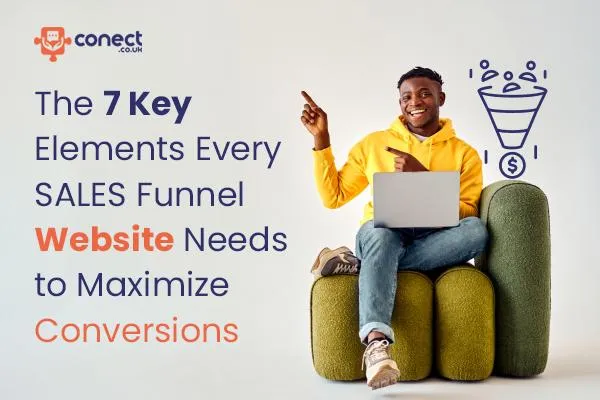
Top Elements Every Sales Funnel Website Needs for Success
The 7 Key Elements Every Sales Funnel Website Needs to Maximize Conversions
Creating an effective sales funnel website is crucial for maximizing conversions and turning casual visitors into loyal customers. A well-optimized funnel strategically guides your audience through each stage of their journey, from initial awareness to final purchase, and even beyond. By focusing on specific elements, you can significantly improve your conversion rates and the overall success of your business.
In this post, we will explore the seven essential components that your website must have to build a high-converting sales funnel. Let’s dive into these key elements and how each contributes to turning your website into a sales powerhouse.
1. Clear and Compelling Value Proposition
The first and most important element of any sales funnel website is a clear value proposition. When visitors land on your page, they should immediately understand what value your product or service offers. This message should be concise, compelling, and speak directly to the needs of your target audience.
Why It Matters
Your value proposition acts as a hook that grabs attention and encourages visitors to stay on your site. If it's unclear, people will leave your page in seconds, and you’ll lose valuable leads.
Tips for Crafting a Strong Value Proposition:
Keep it simple and to the point.
Highlight the benefits your product or service provides.
Use clear language that speaks directly to your target audience's pain points and desires.
Example
Instead of saying, "We offer excellent web development services," try something like, "Get a custom website that converts visitors into customers—designed for your business needs."
2. Effective Lead Capture Forms
Once you have attracted your visitors, you need a system in place to capture their information. A lead capture form is crucial in gathering the details of potential customers, allowing you to continue engaging with them through email or other follow-up methods.
Why It Matters
Lead capture forms are the lifeblood of a sales funnel. Without them, you risk losing contact with visitors who could have converted into paying clients. By collecting essential data like email addresses, you can nurture these leads and guide them further down the funnel.
Best Practices for Lead Capture Forms:
Keep it short and ask for minimal information—name and email should be enough at this stage.
Place the form above the fold (visible without scrolling) so visitors can easily find it.
Offer an incentive, like a free e-book or a discount, to encourage visitors to submit their information.
3. High-Quality Content that Educates and Engages
Content is king in any sales funnel. Once you capture a lead's information, your job is to nurture them with valuable content that builds trust and guides them through the funnel. This content can come in many forms—blog posts, videos, webinars, case studies, and more.
Why It Matters
High-quality content helps build a relationship with your audience. It establishes you as an authority in your field and provides your leads with the information they need to make an informed decision.
Types of Content to Consider:
Blog Posts: Create educational articles that answer common questions in your niche.
Videos: Use video content to showcase your product, customer testimonials, or tutorials.
Webinars: Offer live or recorded webinars to engage leads and provide deeper insights into your services.
Example
A software company could offer blog posts on topics like “How to Improve Your Business Efficiency with Automation,” and then offer a free demo of their software at the end.
4. Social Proof and Testimonials
Trust is a significant factor in the buying decision process. If your website doesn’t offer evidence that your product or service delivers results, visitors will be skeptical. Social proof in the form of testimonials, case studies, and reviews can dramatically increase your conversions by showing real-world success stories.
Why It Matters
People trust what others say about your product more than what you say yourself. Positive feedback from satisfied customers can help build that much-needed trust and push hesitant buyers closer to a decision.
How to Use Social Proof Effectively:
Display customer testimonials prominently on your landing page or product pages.
Include detailed case studies that showcase the real-world results of your service.
Feature customer reviews from third-party sites like Google or Yelp.
Example
A fitness trainer could showcase before-and-after photos and testimonials from clients who have successfully used their program, helping new visitors see the real impact.
5. Optimized Call-to-Action (CTA)
A call-to-action (CTA) is the step where you ask visitors to take the next action, whether that’s booking a consultation, signing up for a free trial, or purchasing a product. Your CTA should be clear, compelling, and easy to find.
Why It Matters
Without a well-placed CTA, your visitors may not know what to do next. A CTA guides them toward the final decision-making step of your funnel, which is crucial for conversions.
Best Practices for CTAs:
Make your CTA stand out by using contrasting colors.
Keep the language action-oriented and urgent, like "Start Your Free Trial" or "Claim Your Discount Now."
Place your CTA at strategic locations throughout your site (e.g., at the top of the page, after a lead capture form, and at the end of your content).
Example
Instead of just "Submit," use "Get My Free E-book Now" or "Book a Free Consultation" to make the CTA more enticing.
6. A Seamless User Experience (UX)
A seamless user experience (UX) is essential to ensuring that visitors can easily navigate through your website without frustration. A clunky or slow website can drive visitors away, resulting in lost sales opportunities.
Why It Matters
A smooth, intuitive UX keeps visitors engaged with your site and ensures they can easily find the information they’re looking for. The more enjoyable and frictionless their experience, the more likely they are to convert.
Elements of a Seamless UX:
Fast loading times (ideally under 3 seconds).
Simple, easy-to-read design with plenty of white space.
Mobile optimization to ensure the site works well on all devices.
Clear and easy-to-find navigation.
Example
A clothing store with an easy-to-use filter system and quick checkout will enhance user experience and increase the chances of completing a purchase.
7. A Simple and Secure Checkout Process
For many businesses, the final step of the sales funnel is the checkout process. This is where you turn interested leads into paying customers. An easy and secure checkout is critical to reduce cart abandonment rates and finalize sales.
Why It Matters
An overly complicated or insecure checkout process can cause visitors to abandon their purchases at the last minute. You want to make sure the process is smooth, simple, and trustworthy.
How to Optimize Your Checkout Process:
Offer multiple payment options (credit cards, PayPal, etc.).
Provide a guest checkout option to speed up the process.
Include security badges and reassure customers that their payment information is safe.
Offer clear shipping and return policies to remove any doubts.
Example
An e-commerce store should display SSL security badges, offer one-click payment options like PayPal, and have a clear, concise checkout page to avoid losing sales.
Conclusion
By integrating these seven key elements into your sales funnel website, you can significantly improve your chances of turning visitors into customers. A well-optimized funnel will guide visitors through every step of their journey, addressing their needs, building trust, and ultimately converting them into loyal clients.
Ready to turn your website into a high-converting sales machine? Start by implementing these changes and watch your conversion rates soar. Don’t wait—maximize your sales today!
Contact us for professional help in optimizing your sales funnel website and increasing your conversions.
Frequently Asked Questions
1. What is a sales funnel?
A sales funnel is a process that guides potential customers through a series of steps, from awareness to conversion. It's designed to turn leads into paying customers.
2. Why is a clear call-to-action important on a sales page?
A strong call-to-action (CTA) guides visitors on what to do next. It helps increase conversions by prompting immediate action, such as making a purchase or signing up.
3. How do landing pages affect sales?
Landing pages focus on specific goals, such as lead generation or sales. They help drive targeted traffic, reducing distractions and increasing the likelihood of conversions.
4. What role does user experience (UX) play in conversions?
Great UX ensures that your website is easy to navigate, fast, and visually appealing. A smooth experience leads to higher engagement and better conversion rates.
5. Why should I use social proof on my website?
Social proof, like testimonials or reviews, builds trust. When potential customers see that others have had positive experiences, they are more likely to convert.
6. How important is a mobile-friendly design for my funnel?
With more people browsing on mobile devices, a mobile-friendly design is crucial. It ensures a seamless experience, keeping visitors engaged and preventing them from leaving.
7. Can email marketing improve my sales funnel?
Yes, email marketing allows you to nurture leads by providing them with relevant content and offers. It's an effective tool for building relationships and driving conversions.
8. What kind of content should I include to boost conversions?
Your content should be valuable, relevant, and persuasive. Offer solutions to your audience’s problems and create compelling reasons for them to take action.
9. How can I track the effectiveness of my funnel?
You can use analytics tools to monitor conversion rates, track visitor behavior, and identify drop-off points. This helps you refine and improve your funnel over time.
10. Should I invest in paid ads to drive traffic to my funnel?
Paid ads can effectively drive targeted traffic to your funnel. When done right, they can bring in leads that are more likely to convert into paying customers.

The All-In-One Solution to grow your business. Capture Free Leads And Conversationally Covert Them Into Customers!
Contact information
Address : Layton Lane, Rawdon, Leeds, LS19 6RG
Phone : +44 7859 775480
Email : [email protected]

